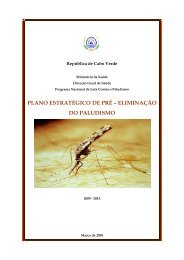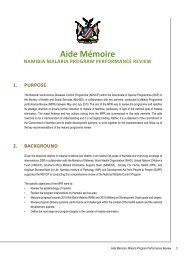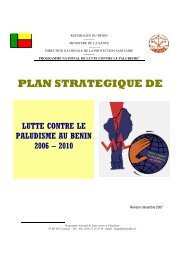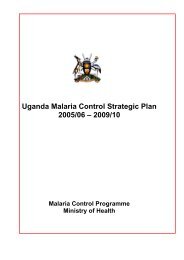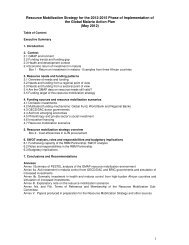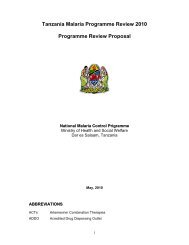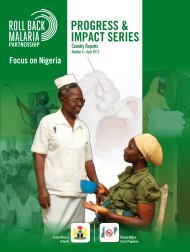Progress & ImPact serIes - Roll Back Malaria - World Health ...
Progress & ImPact serIes - Roll Back Malaria - World Health ...
Progress & ImPact serIes - Roll Back Malaria - World Health ...
Create successful ePaper yourself
Turn your PDF publications into a flip-book with our unique Google optimized e-Paper software.
Map 2.3<br />
Distribution of dominant or potentially important malaria vectors<br />
A wide range of primary vectors exists globally. They are usually the target of most control efforts.<br />
The Americas<br />
An. darlingi<br />
An. aquasalis<br />
An. albitarsis s.l.<br />
An. marajoara<br />
An. nuneztovari s.l.<br />
An. pseudopunctipennis<br />
An. albimanus<br />
An. quadrimaculatus s.l.<br />
An. freeborni<br />
0 1,250 2,500 5,000<br />
Kilometers<br />
Europe & Middle East<br />
An. superpictus<br />
An. sergentii<br />
An. sacharovi<br />
An. messeae<br />
An. labranchiae<br />
An. atroparvus<br />
Africa<br />
An. arabiensis;<br />
An. funestus;<br />
An. gambiae<br />
An. arabiensis;<br />
An. funestus<br />
An. funestus;<br />
An. gambiae<br />
An. gambiae<br />
An. funestus<br />
An. arabiensis<br />
India/Western Asia<br />
An. culicifacies s.l.;<br />
An. stephensi;<br />
An. �uviatilis s.l.<br />
An. �uviatilis s.l.<br />
An. stephensi<br />
An. culicifacies s.l.<br />
The boundaries and names shown and the designations used on this map do not imply the expression of any opinion whatsoever<br />
Source: on the part of <strong>Malaria</strong> the <strong>World</strong> <strong>Health</strong> Atlas Organization Project concerning (17, the 18). legal status of any country, territory, city or area or of its authorities,<br />
or concerning the delimitation of its frontiers or boundaries. Dotted and dashed lines on maps represent approximate border lines<br />
for which there may not yet be full agreement.<br />
The two most important methods of vector<br />
control are ITNs and IRS. ITNs are particularly<br />
effective against mosquitoes that bite late at<br />
night while people are sleeping under the treated<br />
net and IRS is effective against mosquitoes that<br />
bite and rest indoors. ITNs and IRS are much<br />
less effective against species that bite and rest<br />
outdoors such as the forest vector An. Dirus,<br />
which is widespread in Southern Asia. For<br />
these vectors, alternative strategies such as<br />
insecticide-treated hammocks and the use of<br />
personal repellents are sometimes employed.<br />
Some species with readily identified and accessible<br />
breeding sites, such as the urban vector<br />
in India An. stephensii, can be controlled using<br />
larvicidal technologies (spraying of larvicides or<br />
deploying fish which eat Anopheles larvae). Thus,<br />
South-East Asia & Paci�c<br />
An. farauti s.l.;<br />
An. koliensis;<br />
An. punctulatus s.l.<br />
An. dirus s.l.;<br />
An. minimus s.l.<br />
An. lesteri; An. sinensis<br />
An. balabacensis<br />
An. barbirostris s.l.<br />
An. dirus s.l.<br />
An. farauti s.l.<br />
An. �avirostris<br />
Map Production: Public <strong>Health</strong> Information<br />
and Geographic Information Systems (GIS)<br />
<strong>World</strong> <strong>Health</strong> Organization<br />
An. koliensis<br />
An. lesteri<br />
An. leucosphyrus/latens<br />
An. maculatus<br />
An. minimus s.l.<br />
An. punctulatus s.l.<br />
An. sinensis<br />
An. sundaicus s.l.<br />
Map production: Public <strong>Health</strong> Information and Geographic Information Systems (GIS) <strong>World</strong> <strong>Health</strong> Organization.<br />
© WHO 2012. All rights reserved.<br />
vector control for settings outside of Africa must<br />
be carefully chosen to suit the circumstances<br />
prevalent in a country.<br />
Because there is much variation in the behaviour<br />
of vectors that carry malaria, and because<br />
P. falciparum and P. vivax have different<br />
characteristics, the epidemiology of malaria<br />
is highly variable across the world. This report<br />
examines the epidemiology of malaria, and<br />
progress of malaria control, in four geographical<br />
regions outside of Africa. The four regions<br />
illustrate the diversity of situations in which<br />
malaria is encountered and the challenges<br />
for control but it is acknowledged that the<br />
epidemiology of malaria is still highly variable<br />
within these regions.<br />
DEFEATING MALARIA IN ASIA, THE PACIFIC, AMERICAS, MIDDLE EAST AND EuROPE<br />
31




